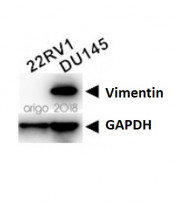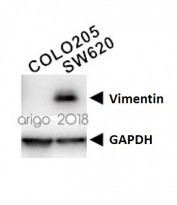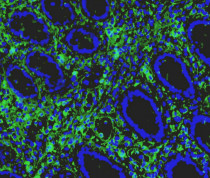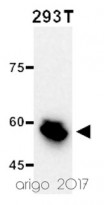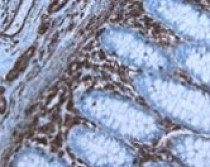ARG66302
anti-Vimentin antibody [SQab1859]
anti-Vimentin antibody [SQab1859] for Flow cytometry,ICC/IF,IHC-Frozen sections,IHC-Formalin-fixed paraffin-embedded sections,Western blot and Human,Mouse,Rat,Chicken,Dog,Goat,Hamster,Monkey,Pig,Xenopus,Zebrafish
Cancer antibody; Controls and Markers antibody; Developmental Biology antibody; Neuroscience antibody; Signaling Transduction antibody; Cancer-associated fibroblast antibody; CAF Marker antibody; EMT Study antibody; Mesenchymal Markers antibody; Fibroblast Marker antibody; Muller Cell Marker antibody; Sarcoma Marker antibody

Overview
| Product Description | Mouse Monoclonal antibody [SQab1859] recognizes Vimentin |
|---|---|
| Tested Reactivity | Hu, Ms, Rat, Chk, Dog, Goat, Hm, Mk, Pig, Xenopus, Zfsh |
| Tested Application | FACS, ICC/IF, IHC-Fr, IHC-P, WB |
| Specificity | This antibody recognizes exclusively with vimentin, which is expressed in mesenchymal cells and mesenchymal derived tumors e.g. lymphoma, sarcoma and melanoma. |
| Host | Mouse |
| Clonality | Monoclonal |
| Clone | SQab1859 |
| Isotype | IgG1 |
| Target Name | Vimentin |
| Antigen Species | Bovine |
| Immunogen | A cytoskeletal Vimentin extract of bovine lens. |
| Conjugation | Un-conjugated |
| Alternate Names | Vimentin; CTRCT30; HEL113 |
Application Instructions
| Application Suggestion |
|
||||||||||||
|---|---|---|---|---|---|---|---|---|---|---|---|---|---|
| Application Note | * The dilutions indicate recommended starting dilutions and the optimal dilutions or concentrations should be determined by the scientist. | ||||||||||||
| Observed Size | ~57 kDa |
Properties
| Form | Liquid |
|---|---|
| Purification | Affinity purification with immunogen. |
| Storage Instruction | For continuous use, store undiluted antibody at 2-8°C for up to a week. For long-term storage, aliquot and store at -20°C or below. Storage in frost free freezers is not recommended. Avoid repeated freeze/thaw cycles. Suggest spin the vial prior to opening. The antibody solution should be gently mixed before use. |
| Note | For laboratory research only, not for drug, diagnostic or other use. |
Bioinformation
| Database Links | |
|---|---|
| Gene Symbol | VIM |
| Gene Full Name | vimentin |
| Background | Vimentin is a type III intermediate filament protein. Intermediate filaments, along with microtubules and actin microfilaments, make up the cytoskeleton. The encoded protein is responsible for maintaining cell shape and integrity of the cytoplasm, and stabilizing cytoskeletal interactions. This protein is involved in neuritogenesis and cholesterol transport and functions as an organizer of a number of other critical proteins involved in cell attachment, migration, and signaling. Bacterial and viral pathogens have been shown to attach to this protein on the host cell surface. Mutations in this gene are associated with congenital cataracts in human patients. [provided by RefSeq, Aug 2017] |
| Function | Vimentins are class-III intermediate filaments found in various non-epithelial cells, especially mesenchymal cells. Vimentin is attached to the nucleus, endoplasmic reticulum, and mitochondria, either laterally or terminally. Involved with LARP6 in the stabilization of type I collagen mRNAs for CO1A1 and CO1A2. [UniProt] |
| Highlight | Related Antibody Duos and Panels: ARG30304 Astrocyte Maturation / Muller Cell Marker Antibody Duo (GFAP, Vimentin) ARG30319 Carcinoma / Sarcoma Antibody Duo Related products: Vimentin antibodies; Vimentin Duos / Panels; Anti-Mouse IgG secondary antibodies; Related news: New antibody panels for Myofibroblasts and CAFs New antibody panels and duos for Tumor immune microenvironment Anti-SerpinB9 therapy, a new strategy for cancer therapy |
| Research Area | Cancer antibody; Controls and Markers antibody; Developmental Biology antibody; Neuroscience antibody; Signaling Transduction antibody; Cancer-associated fibroblast antibody; CAF Marker antibody; EMT Study antibody; Mesenchymal Markers antibody; Fibroblast Marker antibody; Muller Cell Marker antibody; Sarcoma Marker antibody |
| Calculated MW | 54 kDa |
| PTM | Filament disassembly during mitosis is promoted by phosphorylation at Ser-55 as well as by nestin (By similarity). One of the most prominent phosphoproteins in various cells of mesenchymal origin. Phosphorylation is enhanced during cell division, at which time vimentin filaments are significantly reorganized. Phosphorylation by PKN1 inhibits the formation of filaments. Phosphorylated at Ser-56 by CDK5 during neutrophil secretion in the cytoplasm. Phosphorylated by STK33. O-glycosylated during cytokinesis at sites identical or close to phosphorylation sites, this interferes with the phosphorylation status. S-nitrosylation is induced by interferon-gamma and oxidatively-modified low-densitity lipoprotein (LDL(ox)) possibly implicating the iNOS-S100A8/9 transnitrosylase complex. |
Images (7) Click the Picture to Zoom In
-
ARG66302 anti-Vimentin antibody [SQab1859] IHC-P image
Immunohistochemistry: Mouse xenograft tumor stained with ARG66302 anti-Vimentin antibody [SQab1859].
From Jianxia Wei et al. Cancer Sci. (2023), doi: 10.1111/cas.15998, Fig. 6E.
-
ARG66302 anti-Vimentin antibody [SQab1859] WB image
Western blot: 20 µg of 22RV1 and DU145 cell lysates stained with ARG66302 anti-Vimentin antibody [SQab1859] at 1:2000 dilution and ARG65680 anti-GAPDH antibody at 1:10000 dilution.
-
ARG66302 anti-Vimentin antibody [SQab1859] WB image
Western blot: 20 µg of COLO205 and SW620 cell lysates stained with ARG66302 anti-Vimentin antibody [SQab1859] at 1:2000 dilution and ARG65680 anti-GAPDH antibody at 1:10000 dilution.
-
ARG66302 anti-Vimentin antibody [SQab1859] IHC-Fr image
Immunohistochemistry: Frozen section of swine colon stained with ARG66302 anti-Vimentin antibody [SQab1859] (green) at 1:200 dilution. DAPI (blue) staining for cell nuclei.
-
ARG66302 anti-Vimentin antibody [SQab1859] WB image
Western blot: 20 µg of 293T cell lysate stained with ARG66302 anti-Vimentin antibody [SQab1859] at 1:1000 dilution.
-
ARG66302 anti-Vimentin antibody [SQab1859] WB image
Western blot: 20 µg of HeLa and 293T cell lysates stained with ARG66302 anti-Vimentin antibody [SQab1859] at 1:1000 dilution.
-
ARG66302 anti-Vimentin antibody [SQab1859] IHC-P image
Immunohistochemistry: paraffin section of Human colon stained with ARG66302 anti-Vimentin antibody [SQab1859].
Customer's Feedback
Specific References

